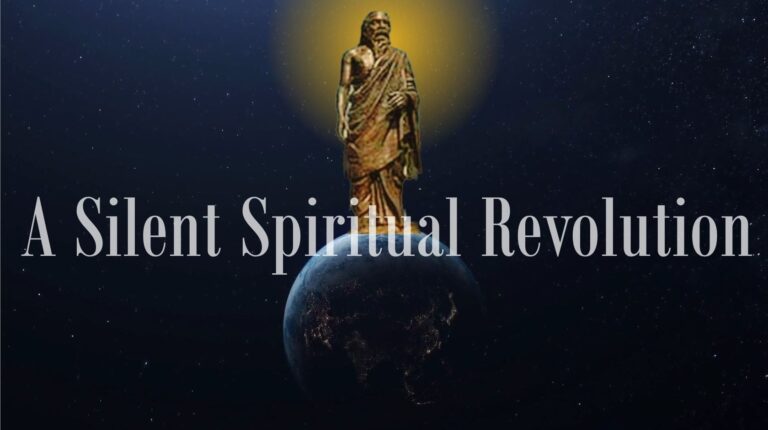There is a common misunderstanding with regard to the role of a Guru and who would it be in the Integral Yoga. This question is typical of the times we live in and needs to be addressed especially in the context of Sri Aurobindo and the Mother’s withdrawal. This talk touches upon this complex subject.
Words of Sri Aurobindo
In this Yoga the whole principle is to open oneself to the Divine Influence. It is there above you and, if you can once become conscious of it, you have then to call it down into you. It descends into the mind and into the body as Peace, as a Light, as a Force that works, as the Presence of the Divine with or without form, as Ananda. Before one has this consciousness, one has to have faith and aspire for the opening. Aspiration, call, prayer are forms of one and the same thing and are all effective; you can take the form that comes to you or is easiest to you. The other way is concentration; you concentrate your consciousness in the heart (some do it in the head or above the head) and meditate on the Mother in the heart and call her in there.
* * *
In this Yoga all depends on whether one can open to the Influence or not. If there is a sincerity in the aspiration and a patient will to arrive at the higher consciousness in spite of all obstacles, then the opening in one form or another is sure to arrive. But it may take a long or a short time according to the prepared or unprepared condition of the mind, heart and body; so if one has not the necessary patience, the effort may be abandoned owing to the difficulty of the beginning. There is no method in this Yoga except to concentrate, preferably in the heart, and call the presence and power of the Mother to take up the being and by the workings of her force transform the consciousness; one can concentrate also in the head or between the eyebrows, but for many this is a too difficult opening. When the mind falls quiet and the concentration becomes strong and the aspiration intense, then there is a beginning of experience. The more the faith, the more rapid the result is likely to be. For the rest one must not depend on one’s own efforts only, but succeed in establishing a contact with the Divine and a receptivity to the Mother’s Power and Presence.
* * *
Keep yourself open to the Mother, remember her always and let her Force work in you, rejecting all other influences that is the rule for Yoga.
* * *
The Guru should be accepted in all ways transcendent, impersonal, personal.
* * *
There are three conditions for a disciple for profiting fully from his relation to a spiritual guide.
1st: He must accept him entirely and him alone without submitting himself to any contrary or second influence.
2nd: He must accept the indications given by the Guru and follow them firmly and with full faith and perseverance to the best of his own spiritual capacity.
3rd: He must make himself open and receptive to the Guru for even more than what the Guru teaches to the mind of the disciple, it is what he spiritually is, the spiritual consciousness, the knowledge, the light, the power, the Divinity in him that helps the disciple to grow by his receiving that into himself and its being used within himself for the growth of his consciousness and nature into its own divine possibility.
* * *
What the Guru can do for the sadhak depends upon the latter’s receptivity not upon any method or rule of sadhana. Certain psychological conditions or attitudes of the consciousness tend to increase the receptivity e.g., humility towards the Guru, devotion, obedience, trust, a certain receptive passivity to his influence.
The opposite things—independence, a critical attitude, questionings go the other way and make it necessary for the Guru to help only indirectly or behind the veil. But the main thing is a kind of psychological openness in the consciousness which comes or increases of itself with the help of the will to receive and the right attitude. If there is that then it is not necessary to pull anything from the Guru, only to receive quietly. Pulling from him often draws untruly or things for which the consciousness is not ready to assimilate.
* * *
Up to now no liberated man has objected to the Guruvada; it is usually only people who live in the mind or vital and have the pride of the mind or the arrogance of the vital that find it below their dignity to recognise a Guru.
* * *
The Guru is the Guide in the Yoga. When the Divine is accepted as the Guide, He is accepted as the Guru.
* * *
It is not usual to use the word Guru in the supramental Yoga, here everything comes from the Divine himself. But if anybody wants it he can use it for the time being.
* * *
The relation of Guru and disciple is only one of many relations which one can have with the Divine, and in this Yoga which aims at a supramental realisation, it is not usual to give it this name; rather, the Divine is regarded as the Source, the living Sun of Light and Knowledge and Consciousness and spiritual realisation and all that one receives is felt as coming from there and the whole being remoulded by the Divine Hand. This is a greater and more intimate relation than that of the human Guru and disciple, which is more of a limited mental ideal. Nevertheless, if the mind still needs the more familiar mental conception, it can be kept so long as it is needed; only do not let the soul be bound by it and do not let it limit the inflow of other relations with the Divine and larger forms of experience.
* * *
Because through it [surrender to the Guru]1 you surrender not only to the impersonal but to the personal, not only to the Divine in yourself but to the Divine outside you; you get a chance for the surpassing of ego not only by retreat into the Self where ego does not exist, but in the personal nature where it is the ruler. It is the sign of the will to complete surrender to the total Divine, samagram mam, manusım tanum asritam. Of course it must be a genuine spiritual surrender for all this to be true.
* * *
Yes [surrender to the formless Divine would leave parts of the being subject to the gunas and ego] because only the static parts would be free in formlessness, the active nature would be still in the play of the gunas. Many think they are free from ego because they get the sense of the formless Existence, they do not see that the egoistic element remains in their action just as before.
* * *
All true Gurus are the same, the one Guru, because all are the one Divine. That is a fundamental and universal truth. But there is also a truth of difference; the Divine dwells in different personalities with different minds, teachings, influences so that He may lead different disciples with their special need, character, destiny by different ways to the realisation. Because all Gurus are the same Divine, it does not follow that the disciple does well if he leaves the one meant for him to follow another. Fidelity to the Guru is demanded of every disciple, according to the Indian tradition. “All are the same” is a spiritual truth, but you cannot convert it indiscriminately into action; you cannot deal with all persons in the same way because they are the one Brahman: if one did, the result pragmatically would be an awful mess. It is a rigid mental logic that makes the difficulty but in spiritual matters mental logic easily blunders; intuition, faith, a plastic spiritual reason are here the only guides.
* * *
To respect the spiritual attainment of X [another spiritual teacher] is all right, but it is a rule of this Yoga not to mix influences (and what he [a sadhak] has described is very much like undergoing an influence). Otherwise there may be harm done by two different methods getting mixed together…
* * *
It is a little difficult for the wider spiritual outlook to answer your question in the way you want and every mental being wants, with a trenchant “Thou shalt” or “Thou shalt not”, especially when the “thou” is meant to cover “all”. For while there is an identity of essential aim, while there are general broad lines of endeavour, yet there is not in detail one common set of rules in inner things that can apply to all seekers. You ask: “Is such and such a thing harmful?” But what is harmful to one may be helpful to another; what is helpful at a certain stage may cease to be helpful at another; what is harmful under certain conditions is helpful under other conditions, what is done in a certain spirit may be disastrous, the same thing done in a quite different spirit would be innocuous or even beneficial. I asked the Mother [?] what she would say to your question about pleasures and social experiences (put as a general question) and she answered, “Impossible to say like that; it depends on the spirit in which it is done.” So there are so many things, the spirit, the circumstances, the person, the need and cast of the nature, the stage. That is why it is said so often that the Guru must deal with each disciple according to his separate nature and accordingly guide his sadhana; even if it is the same line of sadhana for all, yet at every point for each it differs. That also is the reason why we say the Divine’s way cannot be understood by the mind, because the mind acts according to hard and fast rules and standards, while the spirit sees the truth of all and the truth of each and acts variously according to its own comprehension and complex vision. That also is why we say that no one can understand by his personal mental judgment the Mother’s actions and reasons for action: it can only be understood by entering into the larger consciousness from which she sees things and acts upon them. That is baffling to the mind because it loses its small measures, but it is the truth of the matter.



